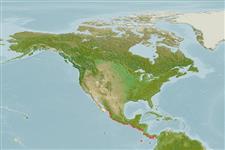Environment: milieu / climate zone / depth range / distribution range
Ecologia
marino; salmastro. Tropical; 25°N - 4°N
Eastern Pacific: Gulf of California to northern Colombia.
Size / Peso / Age
Maturity: Lm ? range ? - ? cm
Max length : 37.4 cm SL maschio/sesso non determinato; (Ref. 95327); common length : 25.0 cm TL maschio/sesso non determinato; (Ref. 55763); peso massimo pubblicato: 626.00 g (Ref. 124487)
Body elongate and somewhat compressed; dorsal profile slightly concave above the eyes; lateral line extending to posterior edge of caudal fin; second anal spine, when folded down, reaching or surpassing origin of caudal fin; pectoral and pelvic fins sub-equal; first gill arch with 26 to 31 gill rakers; back blue gray; belly white; lateral line pale; membranes between dorsal spines and between second and third anal spines pale (Ref. 55763).
Adults are found mainly in estuaries but also enter freshwater to an elevation of 50 m. Diet consists primarily of fish, crustaceans and mollusks (Ref. 36880).
Life cycle and mating behavior
Maturità | Riproduzione | Deposizione | Uova | Fecundity | Larve
Bussing, W.A., 1995. Centropomidae. Róbalos. p. 987-995. In W. Fischer, F. Krupp, W. Schneider, C. Sommer, K.E. Carpenter and V. Niem (eds.) Guia FAO para Identification de Especies para lo Fines de la Pesca. Pacifico Centro-Oriental. 3 Vols. FAO, Rome. (Ref. 9284)
IUCN Red List Status (Ref. 130435)
Threat to humans
Harmless
Human uses
Pesca: commerciale; Pesce da pesca sportiva: si
Informazioni ulteriori
Nomi ComuniSinonimiMetabolismoPredatoriEcotossicologiaRiproduzioneMaturitàDeposizioneSpawning aggregationFecundityUovaEgg development
BibliografiaAcquacolturaProfilo di acquacolturaVarietàGeneticaElectrophoresesEreditarietàMalattieElaborazioneNutrientsMass conversion
CollaboratoriImmaginiStamps, Coins Misc.SuoniCiguateraVelocitàModalità di nuotoArea branchialeOtolithsCervelliVista
Strumenti
Special reports
Download XML
Fonti Internet
Estimates based on models
Preferred temperature (Ref.
123201): 24 - 28.6, mean 27.5 °C (based on 26 cells).
Phylogenetic diversity index (Ref.
82804): PD
50 = 0.5005 [Uniqueness, from 0.5 = low to 2.0 = high].
Bayesian length-weight: a=0.00759 (0.00508 - 0.01134), b=3.03 (2.91 - 3.15), in cm total length, based on LWR estimates for this species & Genus-body shape (Ref.
93245).
Trophic level (Ref.
69278): 3.8 ±0.59 se; based on food items.
Resilienza (Ref.
120179): Alto, tempo minimo di raddoppiamento della popolazione meno di 15 mesi (Preliminary K or Fecundity.).
Fishing Vulnerability (Ref.
59153): Moderate vulnerability (36 of 100).
Nutrients (Ref.
124155): Calcium = 187 [113, 334] mg/100g; Iron = 1.62 [0.97, 2.52] mg/100g; Protein = 19.6 [17.2, 21.9] %; Omega3 = 0.299 [0.130, 0.710] g/100g; Selenium = 37.4 [18.2, 81.0] μg/100g; VitaminA = 14.5 [5.7, 39.0] μg/100g; Zinc = 1.5 [1.1, 2.1] mg/100g (wet weight);
